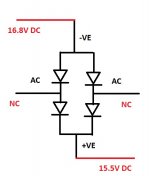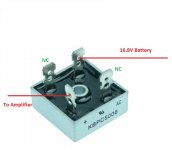I want to power JBL Stage Amplifier A9004 on 4x 18650 lithium batteries that are rated at 4.2v each and am wondering if I can get away with 16.8v so I can get the max power out of it. I understand I can run it at 12.6v, but that's not what I'm here to discuss.
I don't think that anyone would offer a guarantee that you could operate outside of the manufacturers recommended limits.
If the manufacturer has been VERY skimpy in using only 16V components that would work perfectly in an automotive 13.8V environment, then definitely 16.8V would quickly destroy that amplifier.
If the unit has been more conservatively built with higher voltage components, then it would probably be OK on 16.8V.
To be on the safe side I would recommend a 15V buck convertor.
YouTube
If the manufacturer has been VERY skimpy in using only 16V components that would work perfectly in an automotive 13.8V environment, then definitely 16.8V would quickly destroy that amplifier.
If the unit has been more conservatively built with higher voltage components, then it would probably be OK on 16.8V.
To be on the safe side I would recommend a 15V buck convertor.
YouTube
Last edited:
2 diodes in series?
Brian
Could you please elaborate?
Beginner here 😀
Or you could simply put a suitable diode in series with the supply, that would drop approx 0.7V to leave you with 16.1V.
Sorry brig, you beat me to it.
A 50A bridge rectifier would do the job nicely.
Sorry brig, you beat me to it.
A 50A bridge rectifier would do the job nicely.
Attachments
Last edited:
Or you could simply put a suitable diode in series with the supply, that would drop approx 0.7V to leave you with 16.1V.
Sorry brig, you beat me to it.
Could you please recommend which diode I should buy?
Beginner here 😀
16.8/13.8=1.21 so 21% more Voltage.
It depends on the amp construction but usually tolerances are in the 10-20% range.
Well it's a JBL, but to be on the safe side, put one or two diodes in series with the supply.
They should have the same Amperage as the fuse or higher or they will burn.
For example a 1N5408 is a 10A diode. 16.8*10=168W, but if the amp uses a yellow fuse You probably need a heatsinked 20A diode from a computer supply or PSU.
It depends on the amp construction but usually tolerances are in the 10-20% range.
Well it's a JBL, but to be on the safe side, put one or two diodes in series with the supply.
They should have the same Amperage as the fuse or higher or they will burn.
For example a 1N5408 is a 10A diode. 16.8*10=168W, but if the amp uses a yellow fuse You probably need a heatsinked 20A diode from a computer supply or PSU.
Last edited:
Properly designed car electronics won't go up in smoke at 16.8 V; car electronics are normally designed to handle voltage spikes up to 60 V or so, such that they survive when you switch off the starter motor or some other big load, and to handle voltages of around 24 V when you jump start the car from a 24 V truck battery. If you have really bad luck, it might go into some non-functional self-protecting mode, though.
50A 1000V Metal Case Single Phases Diode Bridge Rectifier Kbpc5010 J HwSJUK 701828533687 | eBay
These 50A bridge rectifiers are commonly available but you might need higher current depending on the current draw of the amplifier.
These 50A bridge rectifiers are commonly available but you might need higher current depending on the current draw of the amplifier.
I chose the KBP type bridge for ease of connection with 1/4" lugs.
The 50A variant should be OK at 100A as the diodes are in series / parallel.
It'll need to be mounted on a metal heatsink or chassis but doesn't need any special mounting hardware, the case is isolated from the pins.
The 50A variant should be OK at 100A as the diodes are in series / parallel.
It'll need to be mounted on a metal heatsink or chassis but doesn't need any special mounting hardware, the case is isolated from the pins.
Attachments
Last edited:
Or you could simply put a suitable diode in series with the supply, that would drop approx 0.7V to leave you with 16.1V.
Sorry brig, you beat me to it.
A 50A bridge rectifier would do the job nicely.
Good idea, I didn't think of using a bridge rectifier
Brian
I want to power JBL Stage Amplifier A9004 on 4x 18650 lithium batteries that are rated at 4.2v each
I guess that those are going to be paralleled like 5-6 or better 7-8P
🙄
Other than that, the diode "idea" it's not very smart, IMO.
Better to check if the unit has 16 VL or 25 VL rated capacitors. ( Some strange values about VL can be purposely made for big brands, like 20 VL)
That is correct.The OP has already discounted reducing the voltage by using less cells.
I have't tried the diode approach yet, but if I do, I'll be sure to post the results. It might help someone else.
ALL commercial amplifier designs use diodes in their PSUs. That is from ICE all the way up to home amplifier designs.
I don't understand either - it's simple, and it can protect against accidentally connecting the power the wrong way round - what's not to like?
Brian
Brian
- Home
- Amplifiers
- Class D
- Will a car amp rated 9-16v blow if I power it with 16.8v?

